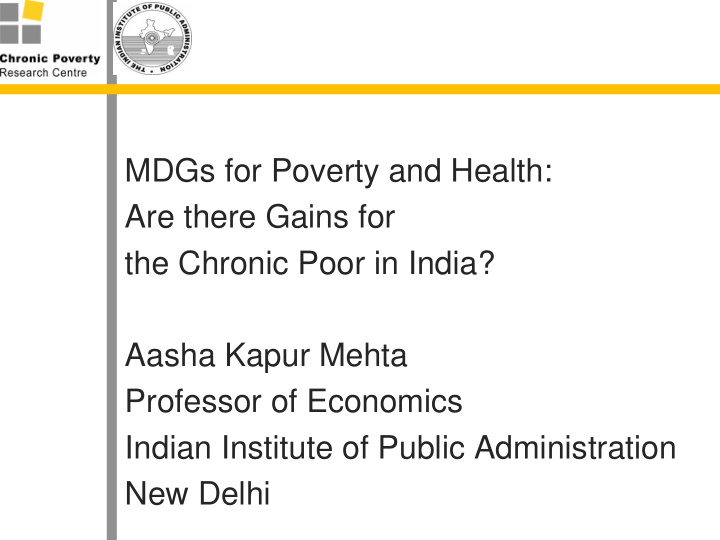



MDGs for Poverty and Health: Are there Gains for the Chronic Poor in India? Aasha Kapur Mehta Professor of Economics Indian Institute of Public Administration New Delhi
Goal 1 : Eradicate extreme poverty and hunger • Percent population in poverty was 36% in 1993-94 • Percent population in poverty is 27.5% in 2004-05. • Reduction much less than anticipated.
Goal 1 : Eradicate extreme poverty and hunger • Target 1: Halve between 1990 and 2015 the proportion of people with income below $ 1 per day. • 8.5% reduction in poverty from 1993- 94 to 2004-05 (11 years). • Need additional reduction of 10% in 10 years to reach target by 2015.
Goal 2: Achieve universal primary education • literacy rate 52% in 1991 • literacy rate 64.8% in 2001 • In 2001: – For boys: 75.3 – For girls: 53.7 • Gender Gaps need to be bridged and likely to be larger for the chronic poor.
Goal 2 : Achieve universal primary education • Target 3: Ensure by 2015, children everywhere, boys and girls alike, will be able to complete a full course of primary schooling. • Literacy rate for 15-24 year olds was: – 64.3% in 1990 – 73.3 % in 2001. – MDG Target is 100% by 2015
• Target 4: Eliminate gender disparity in primary and secondary education, preferably by 2005 and in all levels of education no later than 2015. • Ratio of boys to girls in primary education increased from 0.71 to 0.78 • Target is 1
Goal 4 : Reduce child mortality • Target 5: Reduce by two-thirds, between 1990 and 2015, the under-five mortality rate. • IMR was 80 in 1990. • IMR was 58 in 2005. • However the estimates are far higher at 75 for Orissa, 76 for MP, 73 for UP.
Goal 5 : Improve maternal health • Target 6: Reduce the maternal mortality ratio by three-quarters between 1990 and 2015. • MMR was 437 in 1991 • MMR was 301 in 2001-2003 • MMR 517 for UP/Uttaranchal and 490 for Assam
Goal 6 : Combat HIV/AIDS, malaria and other diseases • Target 7: Have halved by 2015 and begun to reverse the spread of HIV/AIDS • Target 8: Have halted by 2015 and begun to reverse incidence of malaria and other major diseases
Target 7: Halve by 2015 and reverse the spread of HIV/AIDS • The number of persons infected with the virus is disputed and ranges from 5.7 million to 2.47 million depending on source . • Only 10% of those needing ARV received it in 2006
Target 7: Halve by 2015 and reverse the spread of HIV/AIDS • Z is a 25 year old woman with 2 daughters. She is HIV positive. • Her husband died of HIV/AIDS. • She works as a domestic servant and earns Rs 1800 per month. • She spends Rs 1500 on ARV medicine in the of getting access to ARV from the govt hospital. • Her major worry is providing for her daughters and what will happen to them after she dies.
Target 7: Halve by 2015 and reverse the spread of HIV/AIDS • X and her family are suffering the worst form of stark poverty. Home is a 6 foot by 6 foot space, on a footpath in Mumbai under a makeshift roof made of a plastic sheet. • Her husband used to work as a plumber. He earned Rs 3,000 per month before he started falling ill. Frequent opportunistic illness meant stoppage of income and entry into poverty. • They started living on the footpath but the Mumbai Municipal Corporation demolishes the tiny space they live in every few months. The family was contemplating suicide.
Target 7: Halve by 2015 and reverse the spread of HIV/AIDS • The National Rural Health Mission estimates that Hospitalised Indians spend on an average 58 percent of their total annual expenditure on the medical care. • Most do not have insurance and borrow heavily or sell assets to cover expenses.
Target 7: Halve by 2015 and reverse the spread of HIV/AIDS Funds are available for HIV/AIDS: • Domestic public and private funds. • Bilateral and multilateral funds • The Global Fund to fight HIV/AIDS, Tuberculosis and Malaria. And yet, despite several sources of funds, many of those who are HIV affected, do not have access to these funds and incur severe debt and entry into poverty in dealing with medical etc expenditure .
Recommend
More recommend